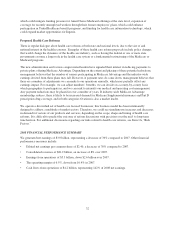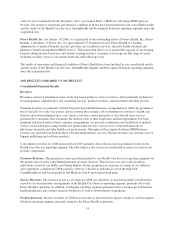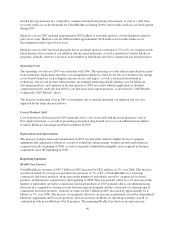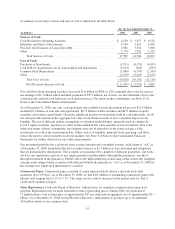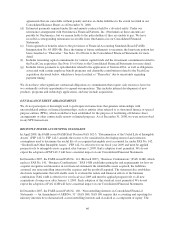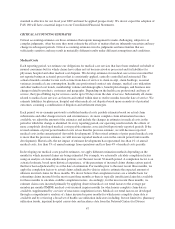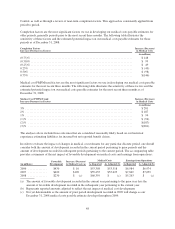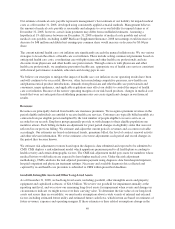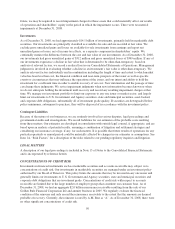United Healthcare 2008 Annual Report Download - page 50
Download and view the complete annual report
Please find page 50 of the 2008 United Healthcare annual report below. You can navigate through the pages in the report by either clicking on the pages listed below, or by using the keyword search tool below to find specific information within the annual report.internal pricing decisions in a competitive commercial risk-based pricing environment, as well as a shift from
favorable medical cost development for UnitedHealthcare during 2006 to unfavorable medical cost development
during 2007.
Medical costs for 2007 included approximately $420 million of favorable medical cost development related to
prior fiscal years. Medical costs for 2006 included approximately $430 million of favorable medical cost
development related to prior fiscal years.
Medical costs for 2007 increased primarily due to an annual medical cost trend of 7% to 8% on commercial risk-
based business due to medical cost inflation and increased utilization, as well as growth in Ovations Medicare
programs, partially offset by a decrease in the number of individuals served by commercial risk-based products.
Operating Costs
The operating cost ratio for 2007 was consistent with 2006. The operating cost ratio reflected productivity gains
from technology deployment and other cost management initiatives, offset by the effect of business mix change
as fee-based businesses such as Ingenix increase in size and impact, as well as increased investment in
technology, service and product enhancements; incremental marketing and advertising costs for Medicare
Advantage products; and expenses in the first quarter of 2007 associated with the application of deferred
compensation rules under Section 409A to our historical stock option practices, as described in “2008 Results
Compared to 2007 Results” above.
The increase in operating costs in 2007 was primarily due to general operating cost inflation and was also
impacted by the items discussed above.
Cost of Products Sold
Cost of products sold increased in 2007 primarily due to costs associated with increased pharmacy sales at
Prescription Solutions as a result of providing prescription drug benefit services to an additional four million
Ovations Medicare Advantage and Part D members in 2007.
Depreciation and Amortization
The increase in depreciation and amortization in 2007 was primarily related to higher levels of computer
equipment and capitalized software as a result of technology enhancements, business growth and businesses
acquired since the beginning of 2006, as well as separately identifiable intangible assets acquired in business
acquisitions since the beginning of 2006.
Reporting Segments
Health Care Services
UnitedHealthcare revenues of $40.3 billion in 2007 increased by $821 million, or 2%, over 2006. This increase
was driven mainly by average net premium rate increases of 7% to 8% on UnitedHealthcare’s renewing
commercial risk-based products, an increase in the number of individuals served by commercial fee-based
products and businesses acquired since the beginning of 2006. This was partially offset by a 4% decrease in the
number of individuals served by commercial risk-based products in 2007 primarily due to our internal pricing
decisions in a competitive commercial risk-based pricing environment and the conversion of certain groups to
commercial fee-based products. Ovations revenues of $26.5 billion in 2007 increased by approximately $1.8
billion, or 7%, over 2006. The increase was primarily driven by an increase in individuals served by standardized
Medicare supplement and Evercare products, and rate increases on Medicare Advantage products as well as
continued growth in our Medicare Part D program. The remaining Health Care Services revenue increase
40




